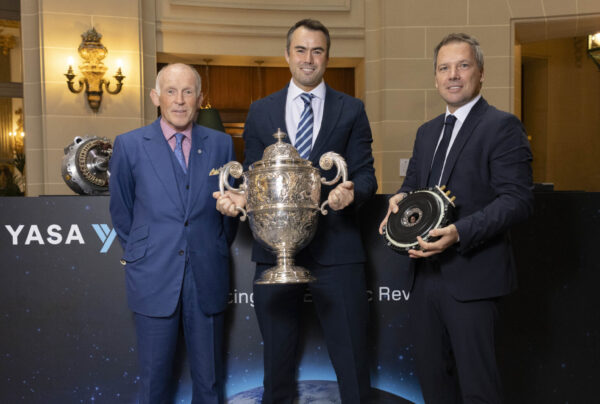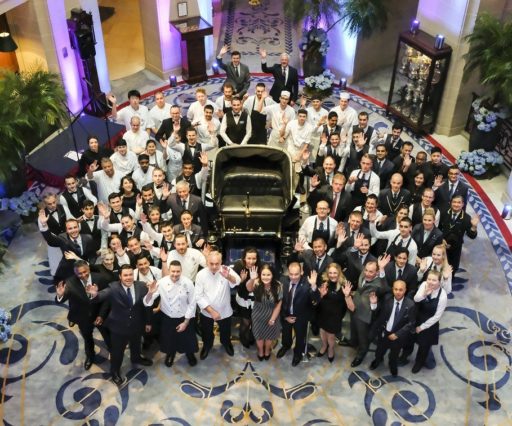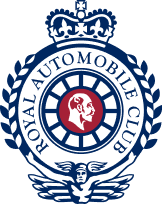The Dewar Trophy
This trophy is awarded for ‘Outstanding British Technical Achievement in the Automotive Industry’.

Renowned as one of the most prestigious awards in British engineering, the Royal Automobile Club’s Dewar Trophy is awarded only in years when the Club’s expert committee believes that there are contenders of sufficient merit, with winners joining a remarkable line-up of automotive greats.
It was presented to the Club in 1904 by Sir Thomas Dewar, MP (later Lord Dewar), and was to be awarded at the discretion of the Club’s Technical Committee for the most meritorious performance by an automobile manufacturer in the Certified Trials held by the Club.
The first recipients of the award in 1906 were Dennis Brothers Limited of Guildford, whose 20hp car covered a distance of 4,000 miles. It was awarded 19 times during the years 1906 to 1929, there being some years when it was considered that no performance had been recorded of sufficient merit to warrant the award.
In 1931 the award was updated to reflect ‘the most outstanding technical achievement accomplished during that year under the competition rules of the Club’. No award was made under these new terms, however, until 1950 – when it went to the Rover Company for the production and performance of the Rover Gas Turbine Powered Car.
The Trophy was not awarded again until 1957, at which time the terms were again changed to those which prevail to this day, namely: ‘for an outstanding British technical achievement in the automotive field during the preceding year’.
Past Winners
2023
YASA for its revolutionary axial-flux electric motor – technology that puts Britain at the forefront of high-performance, zero-emission cars.
2022
Mercedes-AMG High Performance Powertrains in recognition for the successful implementation of its Formula One powertrain in the road-legal Mercedes-AMG ONE hypercar.
2021
JCB for the development of its ABH2 hydrogen fuelled motor.
2019
JCB for the development and introduction into the market of the JCB 19C-1E electric mini excavator – the construction industry’s first fully electric mini excavator.
2018
Integral Powertrain Limited for the development of the integrated electric motors and inverters which powered the 2018 Pikes Peak winning car.
2017
Jaguar for the development of its all-electric, zero emission, high performance I-PACE Concept
2016
Gordon Murray Design for the development and application of the innovative iStream® chassis concept, including its use in the Global Vehicle Trust OX all-terrain vehicle.
2015
GKN Hybrid Power for the development and application to buses of Gyrodrive technology
2014
Mercedes AMG High Performance Power Trains for the development of its Formula One world championship- winning Mercedes-Benz PU106A Hybrid power unit
2013
McLaren Automotive – development and launch of its advanced sell-out McLaren P1™ supercar
2012
Ford Motor Company – development of the 1.0-litre Eco-Boost engine.
2009
Mercedes-Benz High Performance Engines – Formula One Kinetic Energy Recovery Systems (KERS)
2008
Group Lotus plc – development of its Versatile Vehicle Architecture (VVA) Chassis technology as exemplified in the Lotus Evora sportscar
2006
The JCB Dieselmax team – development of the world diesel land speed record-breaking ‘JCB DIESELMAX’ streamliner
2005
Ricardo plc – work on the development of the Dual Clutch Transmission technology as exemplified by the DCT and Active 4WD for the Bugatti Veyron
2004
Delphi Corporation – development of their twin-floating disc ‘Maximum Torque Brake’ system
2003
Jaguar Cars – development of the all-aluminium body structure for the new XJ Series
2002
Ricardo plc – development of its I-MoGen (Intelligent Motor Generator) mild hybrid vehicle
1997
MIRA, the Motor Industry Research Association – development of the M-SIS, Side Impact Simulation System
1995
Rover Group Limited – development of the Holovision system to measure and understand the vibration behaviour and their component parts in order to improve vehicle refinement
1985
Lucas Girling Limited – development of anti-lock braking systems for cars, trucks and motorcycles leading to production of the low cost Stop Control System (SCS) for front wheel drive cars
1984
BL Technology Limited, and the Design Team led by C S King, CBE – a convincing demonstration of automobile design possibilities providing opportunities for significant energy savings as embodied in the experimental vehicle ECV3
1981
BL Cars Limited – efficiency in automobile design in respect of the utilisation of interior space and predicted low cost of ownership of the Austin Metro Car
1977
The Triplex Safety Glass Company Limited – development, manufacture and application to production automobiles of the Ten Twenty safety glass as an outstanding contribution to the safety of automobile occupants
1973
The Dunlop Company Limited – development of DENOVO fail-safe tyre and wheel system, as an outstanding contribution to road safety
1972
The British Leyland Motor Corporation (Truck and Bus Division) – design, development and construction of the Leyland National Bus which represents a radical new approach to the development of a public service vehicle incorporating maximum pay-load and security at minimal cost and maintenance
1971
The British Leyland Motor Corporation, coupled with the name of Mr P M Wilkes – advanced development in Automobile design as exemplified by the Range Rover
1969
Mr Keith Duckworth, BSc., ACGI, – design of the Ford Formula 1 engine which has retained the supremacy of British engineering in Grand Prix racing
1967
The Motor Industry Research Association – for carrying out research and initiating development of the load proportioning system of braking to prevent ‘jack-knifing’ of articulated vehicles
1963
Coventry Climax Engines Limited – for design, development and production of engines which have brought British cars to the forefront of Grand Prix racing
1959
British Motor Corporation and Alec Issigonis – Advanced development in automobile design, as exemplified by the Morris Mini-Minor and Austin Seven
1958
G A Vandervell – Design, development, production and performance of the Vanwall car
1957
The Dunlop Rubber Company Limited – work on disc brakes and research and development of tyres for the M G car, which secured various international speed records
1952
Sunbeam-Talbot Limited – Performance in 1952 International Alpine Rally
1951
Jaguar Cars Limited – Performance in four major international events
1950
The Rover Company Limited – Production and performance of the gas turbine powered car
1929
Miss V Cordery – Invicta chassis – 30,000 miles
1928
C B Wardman – Mercedes Benz heavy oil lorry. Consumption and reliability
1926
Violet Cordery – Invicta Car – 5,000 miles
1925
Rover Company Limited – 13,96h.p. car. Fifty ascents and descents of Bwlch-y-Groes- Merionethshire
1923
Rapson Tyre and Jack Company Limited – Rapson cord tyres – 40,000 miles trial
1922
Armstrong-Siddeley Motors Limited – 10,000 miles trial
1921
John I Thornycroft and Company Limited – ‘BT’ type lorry
1920
The National Benzole Company Limited – 10,000 miles trial
1914
The National Steam Company Limited – National coke fuel motor lorry consumption tests
1913
F.S. Bennett Limited – 1914 model 32.2hp Cadillac car.
1911
The Thomas Transmission Limited – 2,000 miles trial of a lorry and London-Edinburgh and back trial of 13.96hp car. Both fitted with Thomas Transmission
1910
S F Edge – 59.9hp Napier. London to Edinburgh and back top-gear trial
1909
The Daimler Company Limited – Two sleeve-valve engines of 22.8hp and 34.4hp respectively. 132 hours’ bench test and 2,000 miles on Brooklands track
1908
The Anglo-American Motor Company Limited – Standardisation test of three 10hp Cadillac cars
1907
Rolls-Royce Limited – 40.50hp Rolls-Royce. 15,000 miles
1906
Dennis Bros. Limited – 20hp Dennis Car. 4,000 miles


